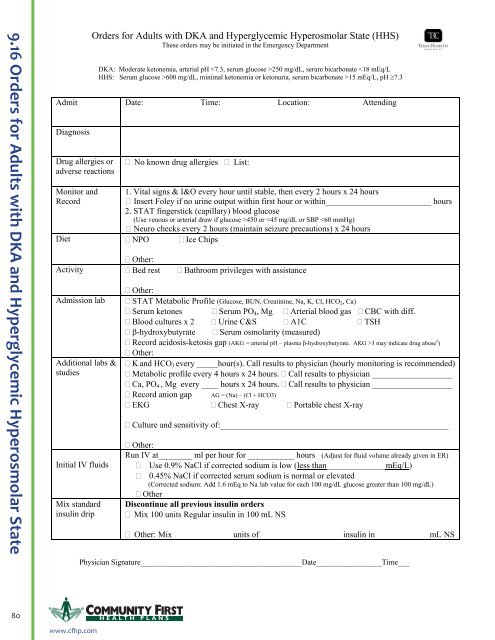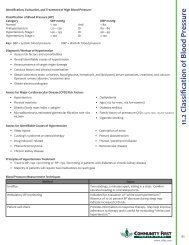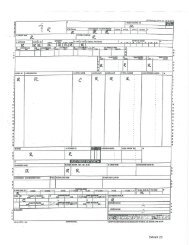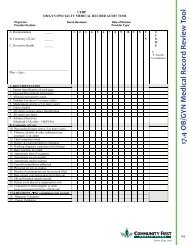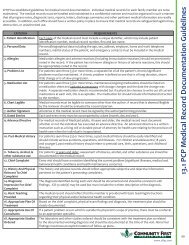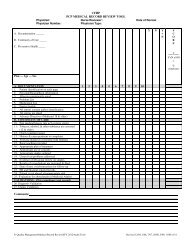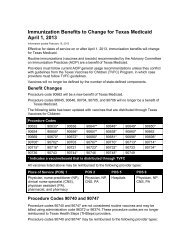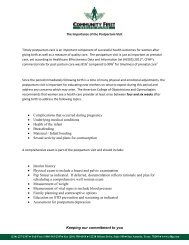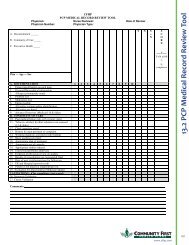9.16 Orders for Adults with DKA and Hyperglycemic Hyperosmolar ...
9.16 Orders for Adults with DKA and Hyperglycemic Hyperosmolar ...
9.16 Orders for Adults with DKA and Hyperglycemic Hyperosmolar ...
You also want an ePaper? Increase the reach of your titles
YUMPU automatically turns print PDFs into web optimized ePapers that Google loves.
<strong>9.16</strong> <strong>Orders</strong> <strong>for</strong> <strong>Adults</strong> <strong>with</strong> <strong>DKA</strong> <strong>and</strong> <strong>Hyperglycemic</strong> <strong>Hyperosmolar</strong> State<strong>Orders</strong> <strong>for</strong> <strong>Adults</strong> <strong>with</strong> <strong>DKA</strong> <strong>and</strong> <strong>Hyperglycemic</strong> <strong>Hyperosmolar</strong> State (HHS)These orders may be initiated in the Emergency Department<strong>DKA</strong>: Moderate ketonemia, arterial pH 250 mg/dL, serum bicarbonate 600 mg/dL, minimal ketonemia or ketonuria, serum bicarbonate >15 mEq/L, pH ≥7.3Admit Date: Time: Location: AttendingDiagnosisDrug allergies oradverse reactionsMonitor <strong>and</strong>Record No known drug allergies List:1. Vital signs & I&O every hour until stable, then every 2 hours x 24 hours Insert Foley if no urine output <strong>with</strong>in first hour or <strong>with</strong>in_________________________ hours2. STAT fingerstick (capillary) blood glucose(Use venous or arterial draw if glucose >450 or
<strong>Orders</strong> <strong>for</strong> <strong>Adults</strong> <strong>with</strong> <strong>DKA</strong> <strong>and</strong> <strong>Hyperglycemic</strong> <strong>Hyperosmolar</strong> State (HHS)These orders may be initiated in the Emergency DepartmentGive initial IVinsulin bolusStart insulininfusionTarget range <strong>for</strong>glucoseMonitor glucoseevery hourAdjust insulininfusion rateTreathypoglycemiaMaintenanceIV fluids Bolus___________ units Regular insulin IV (recommend 10-15 units Regular insulin IV) Other: Bolus units of insulin in mL NSStart insulin infusion at ______________________________ units per hourRecommend infusion rate is calculated as: Glucose mg/dL ÷ 100 (Ex: Glucose=350 → Start 3.5 units/h)Rate of glucose reduction not to exceed 100 mg/dL per hour<strong>DKA</strong>: 100 to 130 mg/dL Other _________________________________HHS: Low target: High target:Obtain lab glucose if fingerstick blood glucose is >450 or
<strong>Orders</strong> <strong>for</strong> <strong>Adults</strong> <strong>with</strong> <strong>DKA</strong> <strong>and</strong> <strong>Hyperglycemic</strong> <strong>Hyperosmolar</strong> State (HHS)These orders may be initiated in the Emergency DepartmentPotassiumreplacementPhosphorusreplacementSodiumbicarbonate(<strong>DKA</strong>)Alert parameters<strong>for</strong> notifyingphysicianCall physician if K is 6 mEq/L (Note: Urine output should be >30 mL/hour be<strong>for</strong>e starting K + replacement)Add KCl to IV fluids:♦ If K is 5.2 mEq/L, hold KCl♦ Consider KPO 4 instead of KCl if serum PO 4 is low Other:Consider if evidence of alcohol abuse, malnutrition, etc. Give 10 mEq/L KPO 4 in one liter of IV fluid x 1 Other:___________________________________________________________________ Give sodium bicarbonateIf pH 1 hour <strong>with</strong> no other source of insulin♦ TPN stopped, interrupted or any change in <strong>for</strong>mulation♦ Deterioration in mental status♦ Patient does not respond to above orders <strong>for</strong> glycemic control Other_________________________________________________________________Transition toSQ insulinOther orders Other _________________________________________________________________ Proceed to Texas Diabetes Council Transition Algorithm From I.V. to S.Q. Insulin Other:1. ________________________________________________________________________________2. ________________________________________________________________________________3.________________________________________________________________________________4. ________________________________________________________________________________References:1. American Diabetes Association. St<strong>and</strong>ards of medical care in diabetes-2008. Diabetes Care. 2008;31(Suppl 1):S12-S54.2. Kitabchi AE, Umpierrez GE, Murphy MB, et al. <strong>Hyperglycemic</strong> crises in adult patients <strong>with</strong> diabetes. A consensusstatement from the American Diabetes Association. Diabetes Care. 2006;29(12):2739-2748.3. American Diabetes Association. <strong>Hyperglycemic</strong> crises in patients <strong>with</strong> diabetes mellitus (Position Statement).Diabetes Care. 2004;27 (Suppl 1):S94-S102.4. Clement S, Braithwaite S, Magee M, et al. Management of diabetes <strong>and</strong> hyperglycemia in hospitals(technical review). Diabetes Care. 2004;27:533-591.5. Lee P, Greenfield JR, Campbell LV. “Mind the gap” when managing ketoacidosis in type 1 diabetes. Diabetes Care.2008;31(7):e58.Physician Signature__________________________________________Date_________________Time___Approved: July 31, 20083 of 382 H EALTH PLANSwww.cfhp.com


